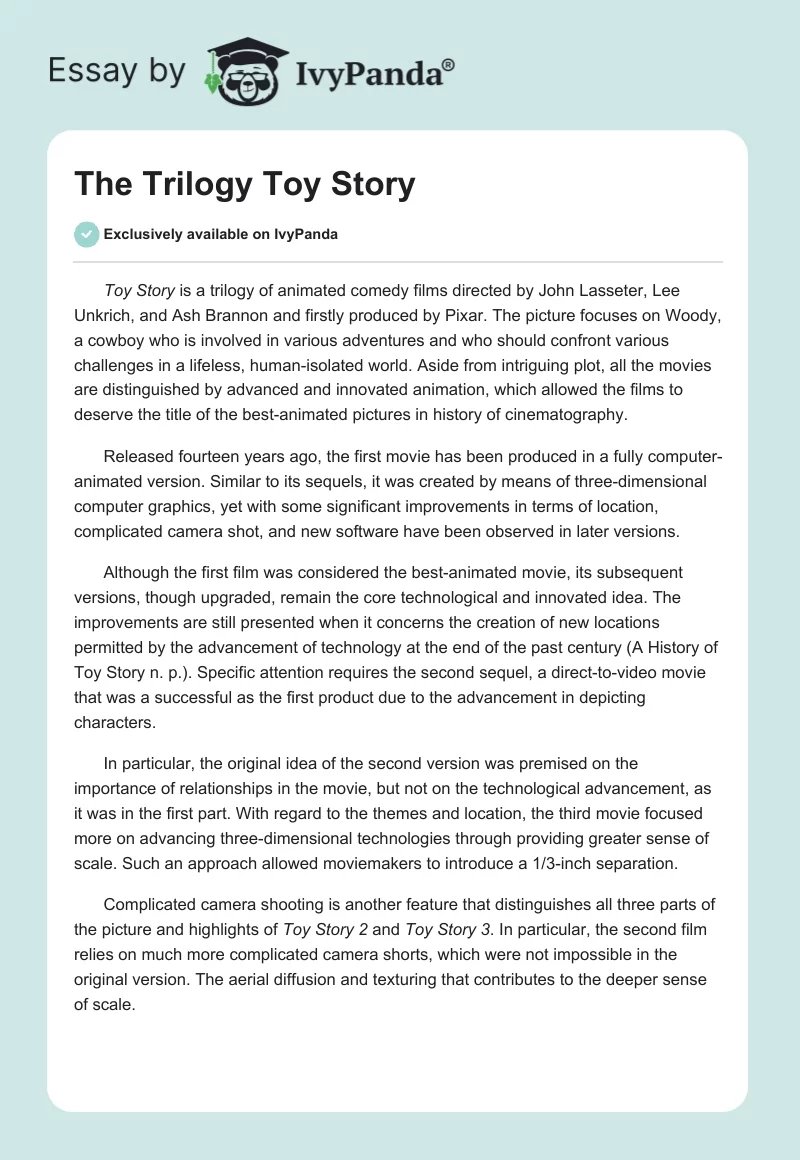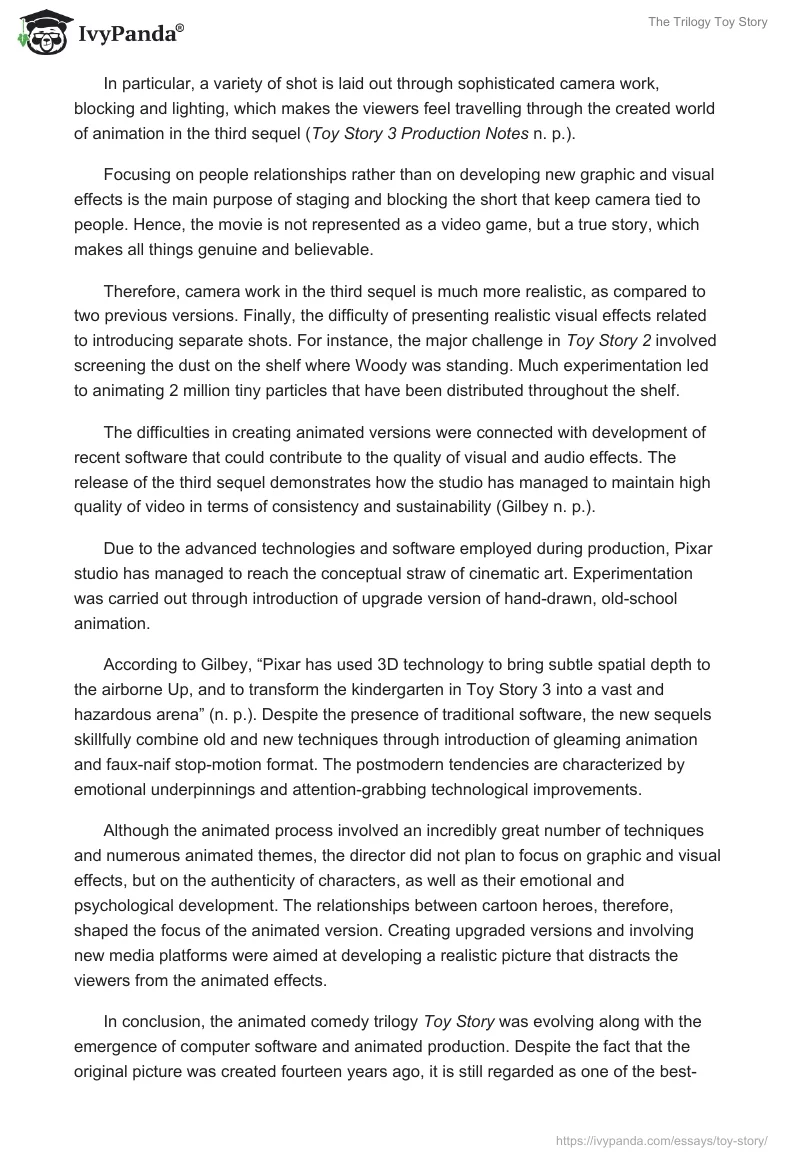Toy Story is a trilogy of animated comedy films directed by John Lasseter, Lee Unkrich, and Ash Brannon and firstly produced by Pixar. The picture focuses on Woody, a cowboy who is involved in various adventures and who should confront various challenges in a lifeless, human-isolated world. Aside from intriguing plot, all the movies are distinguished by advanced and innovated animation, which allowed the films to deserve the title of the best-animated pictures in history of cinematography.
Released fourteen years ago, the first movie has been produced in a fully computer-animated version. Similar to its sequels, it was created by means of three-dimensional computer graphics, yet with some significant improvements in terms of location, complicated camera shot, and new software have been observed in later versions.
Although the first film was considered the best-animated movie, its subsequent versions, though upgraded, remain the core technological and innovated idea. The improvements are still presented when it concerns the creation of new locations permitted by the advancement of technology at the end of the past century (A History of Toy Story n. p.). Specific attention requires the second sequel, a direct-to-video movie that was a successful as the first product due to the advancement in depicting characters.
In particular, the original idea of the second version was premised on the importance of relationships in the movie, but not on the technological advancement, as it was in the first part. With regard to the themes and location, the third movie focused more on advancing three-dimensional technologies through providing greater sense of scale. Such an approach allowed moviemakers to introduce a 1/3-inch separation.
Complicated camera shooting is another feature that distinguishes all three parts of the picture and highlights of Toy Story 2 and Toy Story 3. In particular, the second film relies on much more complicated camera shorts, which were not impossible in the original version. The aerial diffusion and texturing that contributes to the deeper sense of scale.
In particular, a variety of shot is laid out through sophisticated camera work, blocking and lighting, which makes the viewers feel travelling through the created world of animation in the third sequel (Toy Story 3 Production Notes n. p.).
Focusing on people relationships rather than on developing new graphic and visual effects is the main purpose of staging and blocking the short that keep camera tied to people. Hence, the movie is not represented as a video game, but a true story, which makes all things genuine and believable.
Therefore, camera work in the third sequel is much more realistic, as compared to two previous versions. Finally, the difficulty of presenting realistic visual effects related to introducing separate shots. For instance, the major challenge in Toy Story 2 involved screening the dust on the shelf where Woody was standing. Much experimentation led to animating 2 million tiny particles that have been distributed throughout the shelf.
The difficulties in creating animated versions were connected with development of recent software that could contribute to the quality of visual and audio effects. The release of the third sequel demonstrates how the studio has managed to maintain high quality of video in terms of consistency and sustainability (Gilbey n. p.).
Due to the advanced technologies and software employed during production, Pixar studio has managed to reach the conceptual straw of cinematic art. Experimentation was carried out through introduction of upgrade version of hand-drawn, old-school animation.
According to Gilbey, “Pixar has used 3D technology to bring subtle spatial depth to the airborne Up, and to transform the kindergarten in Toy Story 3 into a vast and hazardous arena” (n. p.). Despite the presence of traditional software, the new sequels skillfully combine old and new techniques through introduction of gleaming animation and faux-naif stop-motion format. The postmodern tendencies are characterized by emotional underpinnings and attention-grabbing technological improvements.
Although the animated process involved an incredibly great number of techniques and numerous animated themes, the director did not plan to focus on graphic and visual effects, but on the authenticity of characters, as well as their emotional and psychological development. The relationships between cartoon heroes, therefore, shaped the focus of the animated version. Creating upgraded versions and involving new media platforms were aimed at developing a realistic picture that distracts the viewers from the animated effects.
In conclusion, the animated comedy trilogy Toy Story was evolving along with the emergence of computer software and animated production. Despite the fact that the original picture was created fourteen years ago, it is still regarded as one of the best-animated movie in film industry. Subsequent versions of the franchise were not less successful because visual and graphic effects contributed to the development of realistic plot and authentic characters.
Emotional filling of the picture is also due to the emergence of new locations, greater variety and depth of camera shots, and novelties in software devices. In particular, introducing new location and much experimentation has a potent impact on the reception on the part of the regular viewers. Contributions made by Pixar and Steve Jobs have made the movie even more successful and popular.
Works Cited
“A History of Toy Story”. Retro Junk. 2013. Web.
Gilbey, Ryan. “Toy Story 3: How Pixar Changed Animation”. The Guardian. 2010. Web.
“Toy Story 3 Production Notes”. Pixar Talk. 2013. Web.


